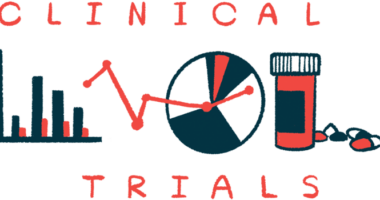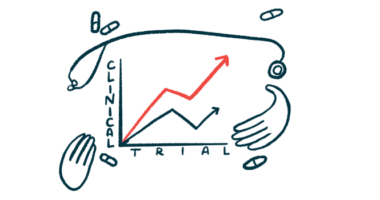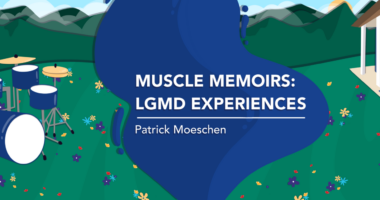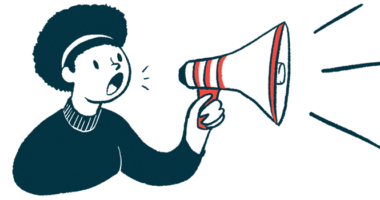Home sweet home: Creating a safe haven for people with DMD
Last updated June 21, 2024, by Susie Strachan
Making home improvements for Duchenne muscular dystrophy (DMD), such as accessible bathrooms and kitchens, ensures you can navigate daily life with greater ease, independence, and safety.
Home adaptations — from widened doorways and ramps to specialized furniture, adaptive equipment, and assistive technology — can make a significant difference in quality of life for people with DMD.
Adapting your home
When trying to decide what home modifications are needed, it can be helpful to get professional advice from a healthcare provider.
An occupational therapist (OT) can evaluate your home’s accessibility and recommend changes.
The OT will start by assessing your physical capabilities and daily routines. Parents and caregivers should be involved in the process as well, along with anyone else who lives in your home.
The OT will then assess your home, looking for areas that should be addressed. They may consider any additional home modifications and equipment that could be needed in the future as DMD symptoms progress.
Your living space
To make a house more accessible, start by looking at your overall living environment. This includes identifying places that could use improvement by:
- reviewing the layout of the living spaces and how easy it is to move around in essential areas including kitchens, bathrooms, and bedrooms
- improving safety by installing nonslip flooring, wider doorways, and brighter lights
- improving access to the house with ramps and stairlifts.
You may want to consider adding an intercom or easy-to-access call buttons in key rooms, such as the bedroom and bathroom, for alerting caregivers if you need help.
Modifying the kitchen
Making the kitchen accessible can help foster independence and inclusion in everyday activities of eating meals and socializing.
Ways to make the kitchen more accessible include:
- lowered countertops and cabinets for more accessibility for wheelchair users
- open shelving for frequently used items to avoid needing to open and close cabinet doors
- D-shaped handles, which are are easier to grip, on cabinets and drawers
- a refrigerator with bottom freezers for easier access
- touchless or lever-handle faucets for the sink
- under-cabinet lighting and task lighting to improve visibility.
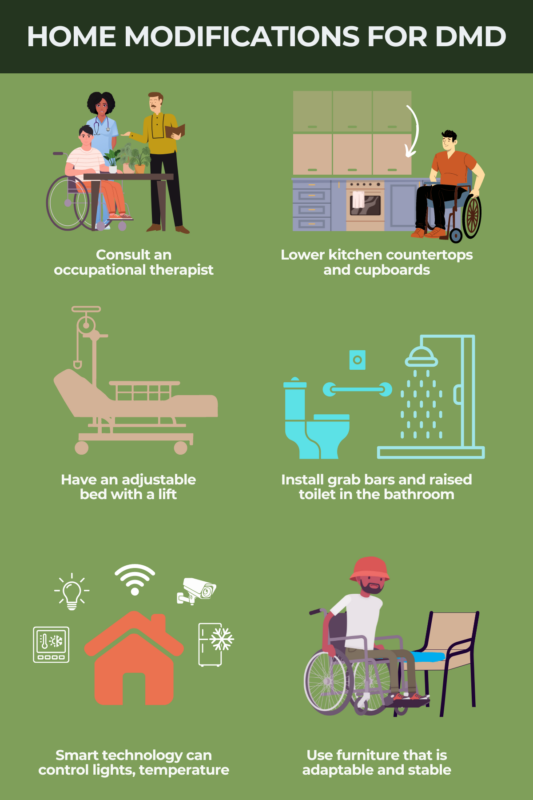
Modifying the bathroom
Making modifications to the bathroom will help with taking care of personal hygiene and make it safer.
Suggested bathroom adaptations include:
- grab bars and handrails around the toilet, shower, and bathtub for additional support during transfers and movement
- a shower chair or bench in the shower
- a roll-in shower for easy entry and exit with a wheelchair
- a raised toilet seat with a frame with armrests for support
- a handheld shower head
- nonskid surfaces to reduce the risk of slips and falls, such as slip-resistant vinyl, textured tiles, and nonslip strips or stickers
- motion-activated lights to avoid reaching for switches
- lever handles or touchless controls on sink, which are easy to operate with limited hand strength.
Modifying the bedroom
While better sleep is the main goal, there may be additional reasons why you require bedroom modifications, such as difficulty breathing at night. Progressive muscle weakness in DMD also can make it hard to maneuver in and out of bed independently.
Some suggested bedroom modifications include:
- an adjustable bed that can be lowered to make transfers easier
- a mechanical lift or hoist to assist with transfers into and out of bed
- bed rails or grab bars for safety and support
- motion-activated or low-level nightlights
- lower shelves and drawers to make items easier to reach.
Smart technology
Smart home technology is a network of devices, systems, and appliances within a home that can be controlled remotely or autonomously through an internet connection.
This type of technology can help you gain greater control over your living environment.
Conserve your energy and reduce reliance on physical assistance for routine tasks by switching to smart technology including:
- smart lights that can be controlled remotely, dimmed, or scheduled to turn on/off
- smart cameras, doorbells, and locks that provide real-time monitoring and alerts
- smart refrigerators, ovens, and washing machines that can be controlled via smartphone apps
- smart thermostats that adjust heating/cooling systems to your preferences.
Assistive devices
Along with making doorways wide enough and floors sturdy enough to handle the weight and size of a power wheelchair or other mobility devices, other modifications may need to be made including:
- a stairlift or a vertical platform lift to make it easier to go up and down levels
- a ceiling-mounted lift system to assist with transfer between a wheelchair and a bed or in the bathroom
- automatic door openers.
Preventing falls and injuries
A slip or fall can be quite serious, potentially causing strained or sprained muscles, broken bones, or even a concussion. Falling also may affect your confidence as you try to avoid doing the movement that caused it.
Prolonged immobility due to injuries can lead to other DMD-associated health issues, such as pressure sores, decreased cardiovascular fitness, and breathing problems.
Proper lighting for better visibility, grab bars and handrails for stability, and ramps instead of stairs are some ways to reduce the risk.
Other ways to help prevent falls and injuries include:
- flooring without small rugs or carpets, which can lead to tripping or slipping
- transition strips to bridge the gap in different types of flooring
- pull-out shelves or lazy Susans to make it easier to reach items in cabinets and cupboards
- floors that are clear of clutter, power cords, and other obstacles.
Adaptable furniture
Choosing adaptable or modular furniture can provide the flexibility to adjust your home’s setup as your needs change.
Adaptable furniture can easily be moved out of the way or folded up for storage. It is also designed to provide the right amount of support for posture issues such as scoliosis.
For example, a motorized bed has different positions to help prevent pressure sores and make transfers easier. Elevating the head and foot areas also can help with breathing.
Electric reclining chairs can be adjusted to reduce pressure points and to help with getting in and out of the chair. Other adaptable chairs might have removable armrests or adjustable seat heights to help with transfers.
Furniture should be arranged to create clear pathways for mobility aids. Other suggestions to increase safety include:
- ensuring furniture is stable and won’t tip over if leaned on for support by weighting the bottom for a lower center of gravity, using nonslip pads under the feet, or positioning furniture in corners or against walls
- securing bookshelves, cabinets, and other heavy furniture to the walls.
Muscular Dystrophy News is strictly a news and information website about the disease. It does not provide medical advice, diagnosis, or treatment. This content is not intended to be a substitute for professional medical advice, diagnosis, or treatment. Always seek the advice of your physician or other qualified health provider with any questions you may have regarding a medical condition. Never disregard professional medical advice or delay in seeking it because of something you have read on this website.
Recent Posts
- Dyne, citing positive trial data, to ask FDA to approve DMD therapy
- My hope for the FSHD community this Advent season
- New trial results highlight gains in arm and heart function for DMD
- Finding the right words to describe our life experiences
- Planning a ‘Krank’ Christmas and getaway with accessibility in mind
Related articles

